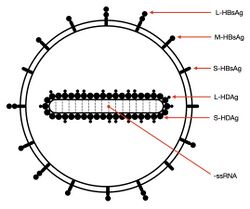Biology:Ribozyviria
| Kolmioviridae | |
|---|---|

| |
| Diagram of a Deltavirus virion | |
| Virus classification | |
| (unranked): | Virus |
| Realm: | Ribozyviria |
| Family: | Kolmioviridae |
| Subtaxa | |
|
1 family
8 genera 15 species See text | |
Ribozyviria is a realm of satellite nucleic acids — infectious agents that resemble viruses, but cannot replicate without a helper virus.[1] Established in ICTV TaxoProp 2020.012D, the realm is named after the presence of genomic and antigenomic ribozymes of the Deltavirus type. The agents in Ribozyviria are satellite nucleic acids, which are distinct from satellite viruses in that they do not encode all of their own structural proteins but require proteins from their helper viruses in order to assemble.[2] Additional common features include a rod-like structure, an RNA-binding "delta antigen" encoded in the genome, and animal hosts.[3] Furthermore, the size range of the genomes of these viruses is between around 1547–1735nt, they encode a hammerhead ribozyme or a hepatitis delta virus ribozyme, and their coding capacity only involves one conserved protein. Most lineages of this realm are poorly understood, the notable exception being the genus Deltavirus, comprising the causal agents of hepatitis D in humans.[4]
The realm Ribozyviria has an unclear evolutionary origin. It has been proposed that they may have derived from retrozymes (a family of retrotransposons) or a viroid-like element (i.e. viroids and satellites) with capsid protein capture.[4][5]
Taxonomy
Historical development
The first taxa of this realm to receive acceptance by the ICTV is the species Hepatitis delta virus and its genus Deltavirus, in 1993. Deltavirus remained unassigned to any higher taxa until 2018, when the ICTV mistakenly classified Deltavirus within the then newly established realm, Riboviria. In 2019, this error was rectified and Deltavirus returned to its original position. In 2020, Hepatitis delta virus was abolished and replaced with eight new species, and the taxonomy developed to reach its current form, detailed below.[6]
Current status
Ribozyviria contains a single family, Kolmioviridae, with no intermediate taxa between realm and family. This family contains eight genera.
The names of all genera in this realm allude to the letter D in various languages. The family name comes from Finnish kolmio "triangle," another reference to the Greek letter "Δ" (delta).[3]
This taxonomy is shown hereafter:[1]
- Realm: Ribozyviria
- Family: Kolmioviridae
- Genus: Daazvirus (from the Gothic alphabet)
- Species: Daazvirus cynopis [Chinese fire belly newt virus 1 (CFBNV-1), formerly amHDV] (host: Cynops orientalis)[7]
- Genus: Dagazvirus (from the Elder Futhark)
- Species: Dagazvirus schedorhinotermitis [rhinotermitid virus 1 (RTV-1), rHDV] (host: Schedorhinotermes intermedius)[7]
- Genus: Daletvirus (from the Hebrew alphabet)
- Species: Daletvirus boae [Swiss snake colony virus 1 (SwSCV-1), formerly sHDV] (host: Boa constrictor, Liasis mackloti savuensis)[8]
- Genus: Dalvirus (from the Arabic alphabet)
- Species: Dalvirus anatis [dabbling duck virus 1 (DabDV-1), formerly avHDV] (host: Anas gracilis, A. castanea, A. superciliosa)[9]
- Genus: Deevirus (from the English alphabet)
- Species: Deevirus actinopterygii [ray-finned fish virus 1 (RFFV-1), formerly fHDV] (host: various Actinopterygii spp.)[7]
- Genus: Deltavirus[1] (from the Greek alphabet)
- Species: Deltavirus cameroonense [human hepatitis delta virus 7 (HDV-7)] (host: Homo sapiens)
- Species: Deltavirus carense [human hepatitis delta virus 6 (HDV-6)] (host: H. sapiens)
- Species: Deltavirus italiense [human hepatitis delta virus 1 (HDV-1)] (host: H. sapiens)
- Species: Deltavirus japanense [human hepatitis delta virus 2 (HDV-2)] (host: H. sapiens)
- Species: Deltavirus peruense [human hepatitis delta virus 3 (HDV-3)] (host: H. sapiens)
- Species: Deltavirus senegalense [human hepatitis delta virus 8 (HDV-8)] (host: H. sapiens)
- Species: Deltavirus taiwanense [human hepatitis delta virus 4 (HDV-4)] (host: H. sapiens)
- Species: Deltavirus togense [human hepatitis delta virus 5 (HDV-5)] (host: H. sapiens)
- Genus: Dobrovirus (from the early Cyrillic alphabet)
- Species: Dobrovirus bufonis [Chusan Island toad virus 1 (CITV-1), formerly tfHDV] (host: Bufo gargarizans)[7]
- Genus: Thurisazvirus (from the Elder Futhark)
- Species: Thurisazvirus myis [Tome's spiny-rat virus 1 (TSRV-1), formerly RDev] (host: Proechimys semispinosus)[10]
- Genus: Daazvirus (from the Gothic alphabet)
- Family: Kolmioviridae
See also
- List of higher virus taxa
- Retrozyme
- Viroid
References
- ↑ 1.0 1.1 1.2 "Virus Taxonomy: 2020 Release". International Committee on Taxonomy of Viruses (ICTV). March 2021. https://ictv.global/taxonomy.
- ↑ Baez, John. "Subcellular Life Forms". http://math.ucr.edu/home/baez/subcellular.html.
- ↑ 3.0 3.1 "Create one new realm (Ribozyviria) including one new family (Kolmioviridae) including genus Deltavirus and seven new genera for a total of 15 species" (in en) (docx). International Committee on Taxonomy of Viruses (ICTV). 6 December 2020. https://ictv.global/ictv/proposals/2020.012D.R.Ribozyviria.zip.
- ↑ 4.0 4.1 Lee, Benjamin D.; Koonin, Eugene V. (2022-01-12). "Viroids and Viroid-like Circular RNAs: Do They Descend from Primordial Replicators?". Life 12 (1): 103. doi:10.3390/life12010103. ISSN 2075-1729. PMID 35054497. Bibcode: 2022Life...12..103L.
- ↑ Netter, Hans J.; Barrios, Marilou H.; Littlejohn, Margaret; Yuen, Lilly K. W. (2021). "Hepatitis Delta Virus (HDV) and Delta-Like Agents: Insights Into Their Origin". Frontiers in Microbiology 12: 1448. doi:10.3389/fmicb.2021.652962. ISSN 1664-302X. PMID 34234753.
- ↑ "Taxonomy History – Taxonomy – ICTV". https://ictv.global/taxonomy/taxondetails?taxnode_id=202005347.
- ↑ 7.0 7.1 7.2 7.3 "Novel hepatitis D-like agents in vertebrates and invertebrates". Virus Evolution 5 (2): vez021. July 2019. doi:10.1093/ve/vez021. PMID 31321078.
- ↑ "Identification of a Novel Deltavirus in Boa Constrictors". mBio 10 (2). April 2019. doi:10.1128/mBio.00014-19. PMID 30940697.
- ↑ "A Divergent Hepatitis D-Like Agent in Birds". Viruses 10 (12): 720. December 2018. doi:10.3390/v10120720. PMID 30562970.
- ↑ "Mammalian deltavirus without hepadnavirus coinfection in the neotropical rodent Proechimys semispinosus". Proceedings of the National Academy of Sciences of the United States of America 117 (30): 17977–17983. July 2020. doi:10.1073/pnas.2006750117. PMID 32651267. Bibcode: 2020PNAS..11717977P.
Further reading
- Ward, C. W. (1993). "Progress towards a higher taxonomy of viruses". Research in Virology 144 (6): 419–53. doi:10.1016/S0923-2516(06)80059-2. PMID 8140287.
Wikidata ☰ Q106951424 entry
 |

